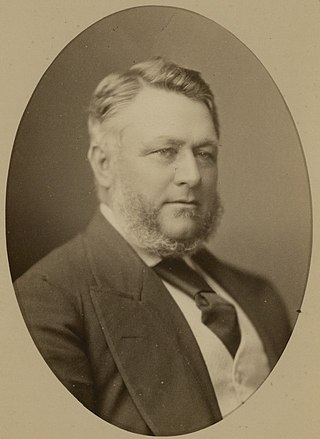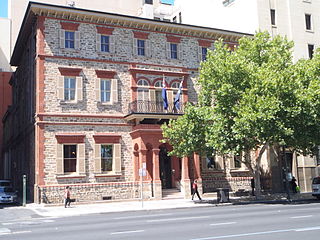
Sir Henry Ayers was the eighth Premier of South Australia, serving a record five times between 1863 and 1873.

North Terrace is one of the four terraces that bound the central business and residential district of Adelaide, the capital city of South Australia. It runs east–west along the northern edge of "the square mile". The western end continues on to Port Road and the eastern end continues across the Adelaide Parklands as Botanic Road.

Norwood is a suburb of Adelaide, about 4 km (2.5 mi) east of the Adelaide city centre. The suburb is in the City of Norwood Payneham & St Peters, whose predecessor was the oldest South Australian local government municipality.

The Adelaide Botanic Garden is a 51-hectare (130-acre) public garden at the north-east corner of the Adelaide city centre, in the Adelaide Park Lands. It encompasses a fenced garden on North Terrace and behind it the Botanic Park. Work was begun on the site in 1855, with its official opening to the public on 4 October 1857.

Stonyfell is an eastern suburb in the foothills of Adelaide, Australia, within the council area of the City of Burnside. It has parks with walking tracks, and two creeks running through it. St Peter's Collegiate Girls' School is the only school in Stonyfell. There is a quarry and a winery, the present-day remnants of industries dating back to the early days of the colonisation of South Australia.

Rundle Street, often referred to as "Rundle Street East" as distinct from Rundle Mall, is a street in the East End of the city centre of Adelaide, the capital of South Australia. It runs from Pulteney Street to East Terrace, where it becomes Rundle Road through the East Park Lands. The street is close to Adelaide Botanic Gardens, Rundle Park, Rymill Park, Hindmarsh Square and North Terrace.

Government House, located in Adelaide on the corner of North Terrace and King William Road, is the official residence of the governor of South Australia.

Adelaide Festival Centre, Australia's first capital city multi-purpose arts centre and the home of South Australia's performing arts, was built in the early 1970s and designed by Hassell Architects. The Festival Theatre opened in June 1973 with the rest of the centre and the Festival Plaza following soon after.

The Adelaide Club is an exclusive gentlemen's club situated on North Terrace in the South Australian capital city of Adelaide. Founded in 1863, the club comprises members of the Adelaide Establishment.
National Trust of South Australia is a membership-based community organisation to "promote the natural, Indigenous and cultural heritage" of South Australia. It was founded in 1955.
Arts South Australia was responsible for managing the South Australian Government's funding for the arts and cultural heritage from about 1996 until late 2018, when it was progressively dismantled, a process complete by early 2019. Most of its functions were taken over by the Department of the Premier and Cabinet (DPC) under Premier Steven Marshall, while some went to the Department for Education and others to the Department for Innovation and Skills.

Edmund William Wright was a London-born architect in the colony of South Australia. He was mayor of Adelaide for 10 months in 1859. He designed many civic, commercial, ecclesiastical, and residential buildings in Adelaide city centre and its suburbs, in styles influenced by French and Italian Renaissance, as well as Neoclassical architecture. He collaborated with other notable architects E. J. Woods, Isidor Beaver, and Edward Hamilton in designing some of the most notable buildings.

Martindale Hall is a Georgian style mansion near Mintaro, South Australia which appeared in the film Picnic at Hanging Rock.

Walter Hervey Bagot was a South Australian architect. He was one of the last great proponents of the traditional school of South Australian architecture. He founded Woods & Bagot in 1905.

David James Speirs is a Scottish-Australian politician, who was the Leader of the Opposition in South Australia and Leader of the South Australian Liberal Party from April 2022 until August 2024. He was a member of the South Australian House of Assembly from the 2014 state election, representing the electorate of Bright from 2014 to 2018, and its successor, the electorate of Black, from 2018 to 2024.
John Benjamin Graham was an English settler in the early days of South Australia, who became very wealthy thanks to his mining interests, then left the colony, but not before establishing a mansion for many years known as "Graham's Castle".

The Santos Museum of Economic Botany, located in the Adelaide Botanic Gardens, displays a permanent collection exhibiting the practical, medicinal and economic use of plant materials.
The History Trust of South Australia, sometimes referred to as History SA, was created as a statutory corporation by the History Trust of South Australia Act 1981, to safeguard South Australia’s heritage and to encourage research and public presentations of South Australian history. It operates three museums in the state: the Migration Museum, the National Motor Museum and the South Australian Maritime Museum. It runs the month-long South Australia's History Festival annually, and manages the Adelaidia and SA History Hub websites. It also manages, in collaboration with the State Library of South Australia, the Centre of Democracy.

Raywood, formerly named Arbury Park, is a property in the Adelaide Hills, South Australia. The 17-room Georgian-style house was constructed in 1935 to designs by Kenneth Milne for noted South Australian and Federal politician, Sir Alexander Downer, who built the house and developed the formal garden as a setting akin to an English estate. Both the house and gardens, are heritage-listed.





















